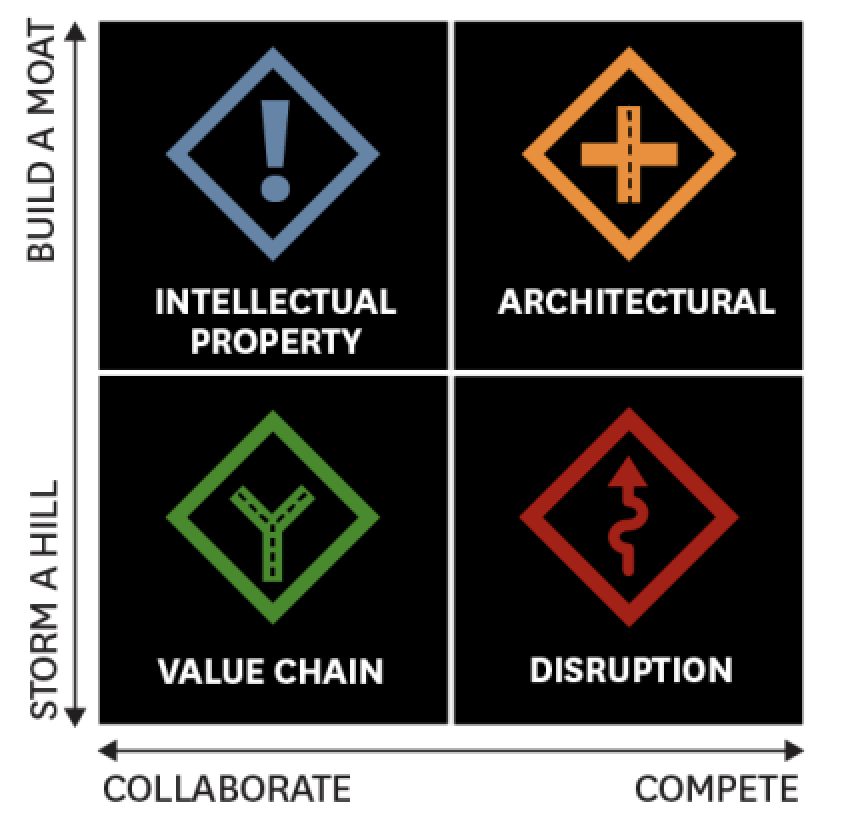The Entrepreneurial Strategy Compass
Outlining the Intellectual Property, Disruption, Value Chain and Architecture models
Feb 14, 2024

In the dynamic landscape of new ventures, strategic opportunities can be evaluated through two critical dimensions. First is the venture's stance towards existing market leaders, known as incumbents: should they collaborate with these established entities or take a stance of competition? The second dimension revolves around the approach to innovation itself: does the venture aim to build an impregnable 'moat' through unique, defensible products, or does it plan to capitalize on its first-mover advantage, rapidly advancing and iterating in uncharted territories?
This dual-axis approach culminates in four distinct strategic pathways. Each pathway not only defines a venture's relationship with competitors and innovation but also shapes its decisions concerning customer engagement, technological adoption, brand identity, and positioning in the competitive landscape. A prime example of utilizing this compass effectively is RapidSOS, an emergency-services provider, which leveraged these strategies to explore and solidify its strategic options in a complex market.
By understanding and applying these dimensions, new ventures can craft a more nuanced and effective strategy that aligns with their unique strengths, market position, and innovation goals.
The Intellectual Property (IP) Strategy: Mastering Innovation and Market Value
The Intellectual Property Strategy hinges on the venture's ability to maintain control over its innovations, thus creating significant value within the existing marketplace. This approach positions the startup as a prolific 'idea factory,' focused on generating and safeguarding unique concepts and technologies.
Under this strategy, the startup engages in strategic partnerships with larger, established incumbents. This collaboration allows the startup to leverage the incumbent's economies of scale, minimizing overhead costs while still retaining control over its intellectual property. In turn, the incumbent benefits from the startup's innovative capabilities – gaining access to high-value, specialized solutions that they might lack the resources or inclination to develop internally.
Key to this strategy is the development choices made by the startup, as these dictate the suitability of potential incumbent partners. Successful collaboration requires a harmonious alignment of goals and capabilities. Therefore, startups often opt for developing generalizable technologies that are compatible with incumbent systems, ensuring seamless integration and mutual benefit.
The identity of the startup in this model is intricately tied to the innovation it develops. These innovations are often brought to market through the incumbent's channels, emphasizing the startup's role in developing small yet crucial modular technologies that can make a significant difference in the industry. This focused approach avoids the pitfalls of unstructured experimentation at every turn.
A classic example of this strategy in action is Dolby Laboratories. Dolby's development of advanced sound technologies for movie theaters exemplifies the IP Strategy. Their proprietary technology, protected by patents, provided a robust defense against competition, preserving their bargaining power and establishing a lasting impact in the audio technology sector.
The Disruption Strategy: Challenging the Status Quo
The disruption strategy is characterized by a startup's intent to challenge and displace existing market leaders. This approach is rooted in the belief that the incumbent's products and services are over-engineered, overpriced, or simply outdated. The startup aims to disrupt the market by offering a simpler, more accessible, and more affordable alternative.
This strategy is often associated with the Lean Startup methodology, which emphasizes rapid iteration and customer feedback. Startups following this approach are focused on creating a minimum viable product (MVP) and quickly bringing it to market. This allows them to test their assumptions and gather feedback from real customers, enabling them to refine their product and business model iteratively.
The Value Chain Strategy: Capturing Value at Every Stage
The Value Chain Strategy focuses on the startup's ability to create and capture value at various stages of the product's lifecycle. This approach emphasizes the startup's role in the production, distribution, and marketing of its products, allowing it to capture a larger share of the value generated by its innovations.
Under this strategy, the startup seeks to control as much of the value chain as possible, from raw materials to the end customer. This allows the startup to capture a larger share of the value generated by its products, increasing its profitability and reducing its dependence on external partners.
The Architecture Strategy: Building the Foundation for Innovation
The Architecture Strategy is centered around the startup's ability to create and control the underlying infrastructure that supports its innovations. This approach emphasizes the startup's role in developing and maintaining the technological and organizational systems that enable its products and services to function effectively.
Under this strategy, the startup focuses on building a robust and scalable architecture that can support its innovations as they grow and evolve. This allows the startup to maintain control over its products and services, ensuring that they remain competitive and relevant in the market.
References
- Do Entrepreneurs Need a Strategy?: https://hbr.org/2018/05/do-entrepreneurs-need-a-strategy#create-something-and-start-selling-it
- The Lean Startup, Ries: https://en.wikipedia.org/wiki/The_Lean_Startup
- Business Model Generation, Alexander Osterwalder, Yves Pigneur: https://www.goodreads.com/book/show/7723797-business-model-generation
- Disciplined Entrepreneurship, Bill Aulet: https://www.goodreads.com/book/show/18652777-disciplined-entrepreneurship
- Gans Foundation Entrepreneurial Strategy: entrepreneurial-strategy-gans-foundation-202005261601.rsrc.pdf
- MIT How Useful is Disruptive Theory?: disruptive-theory-how-useful-202005261606.rsrc.pdf
- Seven Steps For Inventing The Future: https://www.forbes.com/sites/chunkamui/2017/04/04/7-steps-for-inventing-the-future/
#entrepreneur, #strategy, #theory, #startupstrategy, #disrupt, #valuenetwork, #hbr, #architecture, #christensen, #strategy, #businessmodel, #valuenetwork, #valuechain